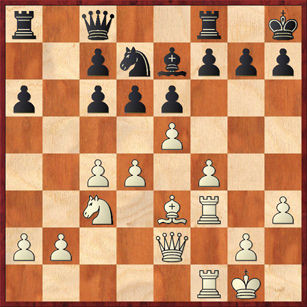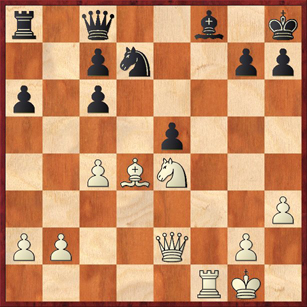First post of the year! I hope everyone enjoyed their holidays.
The chess club at Borders last night was absolutely packed — I think I heard Jim Parker say that we had 26 people. The only problem with Borders is that they won’t let us take over the whole cafe, so we really have trouble fitting any more than 24 players. But we managed somehow.
The top quad last night had a new face. Arek Paterek is a visiting researcher from Poland, who has come to spend a year in the school of engineering at the University of California at Santa Cruz. He lives in Warsaw, and has a FIDE rating of 2048, which was easily high enough to put him in the top quad with me, Ilan Benjamin, and Yves Tan. It’s always exciting to get a new person in the top quad, because I tend to get tired of playing the same people every week. It’s especially exciting when the new person comes from another country! There’s a certain amount of curiosity — how will a 2048 player from Poland compare to a 2048 player from the U.S.? Also, I have to admit, I had an extra incentive to play well against him, because I didn’t want him to write home and say that all the chess players in America are weak!
As it turned out, I played three really good games last night, which made me think that I’m really learning something from teaching ChessLectures and listening to them. I have a couple of good quiz positions for you. First, let’s take a position from my first-round game against Yves:
As Black, I obviously have a good position, as Yves has been placed very much on the defensive. But all of White’s weaknesses are protected at the moment, and he is getting ready to evict my rook with Bd1 or Rd3. How should Black proceed to increase his advantage?
In this position I remembered very clearly Jesse Kraai’s advice on ChessLecture to create a second weakness in my opponent’s camp, because two weaknesses in the endgame are usually fatal. So I hit very quickly on the plan of trying to open the h-file with … g5. I actually decided to play 30. … Rb8 first, which was probably a move-order error — I should have just played 30. … g5 right away. However, the move order turned out not to matter, and the next few moves went exactly according to plan: 31. Bd3?! (the computer says that 31. b4 is a better try) g5 32. hg hg 33. Re2 Rh8! Now if White plays 34. Kg1 or Kg2, he will lose one of the kingside pawns. Very low on time, Yves played the desperate 34. f4?, which lost to 34. … Rh2+ 35. Ke1 Rh1+ 36. Kd2 gf 37. b4 fg and White resigned.
It’s possible that I would have hit on the right plan even if I hadn’t listened to Jesse’s lectures, but there is no question that his lectures made me more confident. That was important, because we were in a low-time situation and I was able to play my moves very quickly, while Yves was struggling to find a plan.
I was very pleased with that game, which actually resembled good chess in spite of the game/25 time control. My game against Paterek resembled good chess even more strongly. The first few moves (I was White) were 1. e4 Nf6 2. e5 Nd5 3. d4 d6 4. f4?! Nc6 5. Nf3 Bg4 6. Bb5 a6 7. Bxc6+ bc 8. c4 Nb6 9. O-O e6 10. Qe2 Be7 11. Be3 O-O 12. Nc3 Qc8 13. h3 Bxf3?! 14. Rxf3 Kh8 15. Raf1 Nd7, leading to the following position:
Those of you who are familiar with my style can probably predict my move immediately: 16. f5! There is no knight hopping to f4 this time (as in my ChessLecture on “Switching Gears from Strategy to Tactics”), but there are lots of good reasons for playing this move. Most importantly, it opens a file for White’s rooks, and it also opens a diagonal for White’s bishop. Black can win a pawn, but the pawn(s) on the e-file will be very weak.
If this had been a tournament game I would probably have spent 10 or 15 minutes analyzing this move, but because it was a 25-minute game I played it mostly on instinct. It turned out that my instinct was pretty good this time. The game continued 16. … de 17. fe fe 18. Rxf8+ Bxf8 19. Ne4! (bringing an important soldier into the battle) ed 20. Bxd4 e5, arriving at this position:
Here’s our second quiz for the day, which this time is completely tactical: How should White continue in this position?
I eventually ended up winning the game. After two very nice victories to start out the year, I was content to agree to a draw in my game with Ilan. So the final results of the quad were Mackenzie 2.5, Paterek 1.5, Benjamin 1.5, Tan 0.5. I look forward to some more international competition in the future, with Juande Perea (from Spain) and Arek Paterek (from Poland) both in the same section! Juande was there last night, but unfortunately because of bad weather he arrived too late to play in the quad, and just had to watch.
Answer to third diagram: Here I played 21. Ng5! The point is that 21. … ed? would lose to 22. Nf7+ Kg8 23. Qe6! White threatens Nh6 double check followed by Qg8 mate, and to stop this Black would be forced to give up his queen (for example, 23. … h6 24. Nd6+).
My opponent actually played the best defense. After 21. Ng5, he played 21. … Qe8! 22. Qe4! Qg6! (Note that 22. … g6 would have been inferior because of 23. Be3 Bg7 24. Qxc6, when Black has serious weaknesses on both c7 and f7. With 22. … Qg6 Black defends the c6 pawn.) 23. Nf7+ Kg8 24. Qxg6 hg 25. Nxe5 Nxe5 26. Bxe5. Clearly White has a significant advantage because of Black’s mangled pawn structure. I wasn’t certain that this would be enough to win, but after 26. … Bc5+ 27. Kh1 Bd6 28. Bc3 Re8 29. Re1 Rxe1+ 30. Bxe1 I was able to grind out a win in the bishop-and-pawn endgame.






{ 3 comments… read them below or add one }
In the last diagram, Dana against Paterek, I would have played 21. Qh5? but black can take the bishop or play 21… Qe8, and it both cases it looks like White has nothing better than a draw. The line 21. Qh5 exd4 22. Ng5 h6 23. Nf7+ Kg8 24. Nxh6+ gxh6 25. Qg6+ Bg7 26. Rf7 Qf8 27. Rxf8 Rxf8 seems to be better for Black as the three pieces and the passed d pawn may be more than a match for the White Queen. Dana found the right move, 21. Ng5!
We can see the f5 – Nf4 shuffle in the Kamsky vs Ponomariov World Cup game won by Kamsky.
After 21. Qh5, I saw that 21. … Qe8 leaves White without an attack, and so I didn’t even look at the riskier 21. … dc. But your analysis looks right to me.
I still feel a little bit lucky, by the way, because when I played 16. f5 I absolutely did not foresee the key idea of Ne4 and Ng5 and Qe4, and without those last two moves coming just in the nick of time, the whole pawn sac would have been a little bit dubious. This was a case of “fortune favores the brave.”